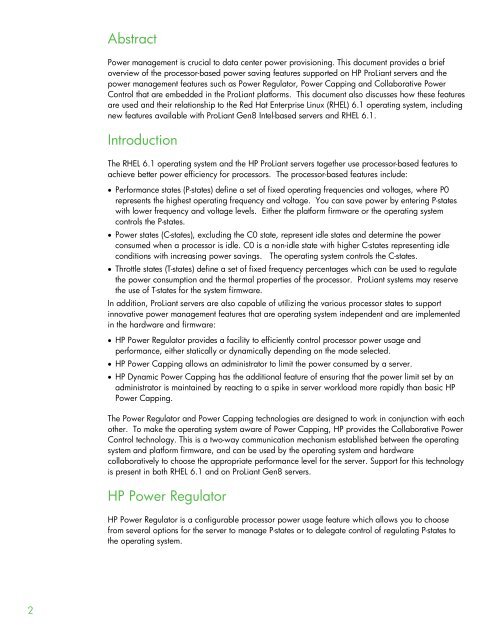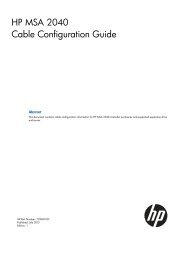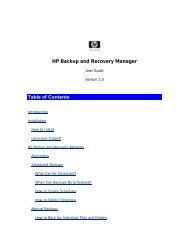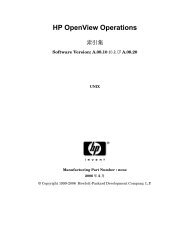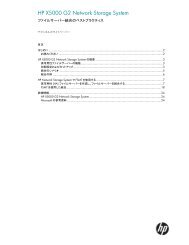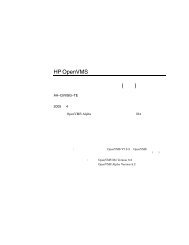HP ProLiant Server Power Management - Hewlett Packard
HP ProLiant Server Power Management - Hewlett Packard
HP ProLiant Server Power Management - Hewlett Packard
Create successful ePaper yourself
Turn your PDF publications into a flip-book with our unique Google optimized e-Paper software.
2<br />
Abstract<br />
<strong>Power</strong> management is crucial to data center power provisioning. This document provides a brief<br />
overview of the processor-based power saving features supported on <strong>HP</strong> <strong>ProLiant</strong> servers and the<br />
power management features such as <strong>Power</strong> Regulator, <strong>Power</strong> Capping and Collaborative <strong>Power</strong><br />
Control that are embedded in the <strong>ProLiant</strong> platforms. This document also discusses how these features<br />
are used and their relationship to the Red Hat Enterprise Linux (RHEL) 6.1 operating system, including<br />
new features available with <strong>ProLiant</strong> Gen8 Intel-based servers and RHEL 6.1.<br />
Introduction<br />
The RHEL 6.1 operating system and the <strong>HP</strong> <strong>ProLiant</strong> servers together use processor-based features to<br />
achieve better power efficiency for processors. The processor-based features include:<br />
• Performance states (P-states) define a set of fixed operating frequencies and voltages, where P0<br />
represents the highest operating frequency and voltage. You can save power by entering P-states<br />
with lower frequency and voltage levels. Either the platform firmware or the operating system<br />
controls the P-states.<br />
• <strong>Power</strong> states (C-states), excluding the C0 state, represent idle states and determine the power<br />
consumed when a processor is idle. C0 is a non-idle state with higher C-states representing idle<br />
conditions with increasing power savings. The operating system controls the C-states.<br />
• Throttle states (T-states) define a set of fixed frequency percentages which can be used to regulate<br />
the power consumption and the thermal properties of the processor. <strong>ProLiant</strong> systems may reserve<br />
the use of T-states for the system firmware.<br />
In addition, <strong>ProLiant</strong> servers are also capable of utilizing the various processor states to support<br />
innovative power management features that are operating system independent and are implemented<br />
in the hardware and firmware:<br />
• <strong>HP</strong> <strong>Power</strong> Regulator provides a facility to efficiently control processor power usage and<br />
performance, either statically or dynamically depending on the mode selected.<br />
• <strong>HP</strong> <strong>Power</strong> Capping allows an administrator to limit the power consumed by a server.<br />
• <strong>HP</strong> Dynamic <strong>Power</strong> Capping has the additional feature of ensuring that the power limit set by an<br />
administrator is maintained by reacting to a spike in server workload more rapidly than basic <strong>HP</strong><br />
<strong>Power</strong> Capping.<br />
The <strong>Power</strong> Regulator and <strong>Power</strong> Capping technologies are designed to work in conjunction with each<br />
other. To make the operating system aware of <strong>Power</strong> Capping, <strong>HP</strong> provides the Collaborative <strong>Power</strong><br />
Control technology. This is a two-way communication mechanism established between the operating<br />
system and platform firmware, and can be used by the operating system and hardware<br />
collaboratively to choose the appropriate performance level for the server. Support for this technology<br />
is present in both RHEL 6.1 and on <strong>ProLiant</strong> Gen8 servers.<br />
<strong>HP</strong> <strong>Power</strong> Regulator<br />
<strong>HP</strong> <strong>Power</strong> Regulator is a configurable processor power usage feature which allows you to choose<br />
from several options for the server to manage P-states or to delegate control of regulating P-states to<br />
the operating system.


